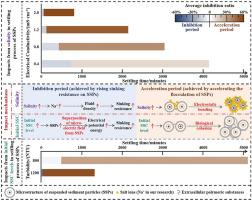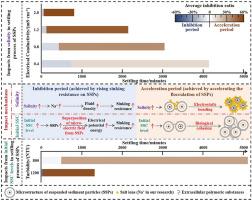Effects of freshwater salinity on suspended sediment settling during different high-turbidity events
IF 7.3
2区 环境科学与生态学
Q1 ENVIRONMENTAL SCIENCES
引用次数: 0
Abstract
Understanding the changes in suspended sediment settling during high-turbidity events (HTEs) under different salinity conditions—from freshwater to mildly saline (0–2 ppt)—is important for assessing risks to aquatic life. Hydrostatic settling experiments were conducted with different salinity levels (electrical conductivity [EC] = 0.3, 0.4, 0.8, 1.2, and 2.0 mS/cm) and initial suspended sediment concentrations (SSCs; turbidity = 400, 800, and 1200 NTU) to evaluate the effects of salinity on sedimentation after HTEs. Compared to the control set (EC = 0.3 mS/cm), increasing initial salinity inhibited the settling velocity of suspended sediment particles (SSPs) for 44–600 min during the early settling stage. In this stage, the hindering effects of liquid density and viscosity dominated the settling rather than flocculation. A similar trend was observed when SSC was the single variable: compared to the 400 NTU set, the increase in the cumulative turbidity reduction ratio in the 800 and 1200 NTU sets was delayed by 40–400 min. Overall, increasing salinity level and initial SSC accelerated SSP settling throughout the experiments. The total mean turbidity reduction rate was positively correlated with salinity level and initial SSC (0.07–0.94 NTU/min). However, at high initial SSC (turbidity ≥1200 NTU), the acceleration effect of slightly saline levels (EC ≤ 0.8 mS/cm) was negligible.


不同高浊度条件下淡水盐度对悬浮泥沙沉降的影响
了解不同盐度条件下(从淡水到轻度盐水(0-2 ppt))高浊度事件(HTEs)期间悬浮沉积物沉降的变化,对于评估水生生物的风险非常重要。通过不同盐度水平(电导率[EC] = 0.3、0.4、0.8、1.2和2.0 mS/cm)和初始悬浮沉积物浓度(SSCs;浊度= 400、800和1200 NTU)进行静水沉降实验,评估盐度对HTEs后沉积的影响。与控制组(EC = 0.3 mS/cm)相比,初始盐度的增加抑制了悬浮泥沙颗粒(ssp)在早期沉降阶段的沉降速度(44 ~ 600 min)。在这一阶段,液体密度和粘度的阻碍作用主导了沉降而不是絮凝。当SSC为单一变量时,观察到类似的趋势:与400 NTU集相比,800和1200 NTU集的累积浊度降低率的增加延迟了40-400分钟。总体而言,盐度水平和初始SSC的增加加速了整个试验过程中SSP的沉降。总平均浊度降低率与盐度水平和初始SSC呈正相关(0.07 ~ 0.94 NTU/min)。然而,在高初始SSC(浊度≥1200 NTU)时,微盐水水平(EC≤0.8 mS/cm)的加速效应可以忽略不计。
本文章由计算机程序翻译,如有差异,请以英文原文为准。
求助全文
约1分钟内获得全文
求助全文
来源期刊

Environmental Pollution
环境科学-环境科学
CiteScore
16.00
自引率
6.70%
发文量
2082
审稿时长
2.9 months
期刊介绍:
Environmental Pollution is an international peer-reviewed journal that publishes high-quality research papers and review articles covering all aspects of environmental pollution and its impacts on ecosystems and human health.
Subject areas include, but are not limited to:
• Sources and occurrences of pollutants that are clearly defined and measured in environmental compartments, food and food-related items, and human bodies;
• Interlinks between contaminant exposure and biological, ecological, and human health effects, including those of climate change;
• Contaminants of emerging concerns (including but not limited to antibiotic resistant microorganisms or genes, microplastics/nanoplastics, electronic wastes, light, and noise) and/or their biological, ecological, or human health effects;
• Laboratory and field studies on the remediation/mitigation of environmental pollution via new techniques and with clear links to biological, ecological, or human health effects;
• Modeling of pollution processes, patterns, or trends that is of clear environmental and/or human health interest;
• New techniques that measure and examine environmental occurrences, transport, behavior, and effects of pollutants within the environment or the laboratory, provided that they can be clearly used to address problems within regional or global environmental compartments.
 求助内容:
求助内容: 应助结果提醒方式:
应助结果提醒方式:


